Abstract
High-precision in situ δ18O values obtained using secondary ion mass spectrometry (SIMS) for μm-size quartz cement are applied to constrain the origin of the silica in the deep-buried Upper Triassic second member of Xujiahe Formation tight sandstones, western Sichuan Basin, China. Petrographic, cathodoluminescence (CL), and fluid inclusion data from the quartz cements in the Xu2 sandstones indicate three distinct, separate quartz precipitation phases (referred to as Q1, Q2, and Q3). The Q1 quartz cement was formed at temperatures of approximately 56–85 °C and attained the highest δ18O values (ranging from 18.3 to 19.05‰ Vienna Standard Mean Ocean Water (VSMOW)). The Q2 quartz cement was generated at temperatures of approximately 90–125 °C, accompanying the main phase of hydrocarbon fluid inclusions, with the highest Al2O3 content and high δ18O values (ranging from 15 to 17.99‰ VSMOW). The Q3 quartz cement was formed at temperatures of approximately 130–175 °C, with the lowest δ18O values (ranging from 12.79 to 15.47‰ VSMOW). A portion of the Q2 and Q3 quartz cement has a relatively high K2O content. The dissolution of feldspar and volcanic rock fragments was likely the most important source of silica for the Q1 quartz cement. The variations in δ18O(water) and trace element composition from the Q2 quartz cement to the Q3 quartz cement suggest that hydrocarbon emplacement and water-rock interactions greatly altered the chemistry of the pore fluid. Feldspar dissolution by organic acids, clay mineral reactions (illitization and chloritization of smectite), and pressure dissolution were the main sources of silica for the Q2 and Q3 quartz cements, while transformation of the clay minerals in the external shale unit was a limited silica source.
1. Introduction
Quartz cement is the volumetrically most significant diagenetic mineral altering porosity in deep-buried sandstones, which occurs in mature, medium- to coarse-grained quartz arenites, typical of tectonically stable cratonic basins [,,]. Understanding the origin and distribution of quartz cement is consequently of economic importance for reservoir quality prediction in oilfield sandstones []. Although authigenic quartz cements have been extensively studied, the pH, temperature, pressure, detrital composition, oil and gas emplacement, and chlorite coating play an important role in the precipitation of authigenic quartz, but the formation mechanism and accurate formation time of authigenic quartz are not fully understood [,,,]. A certain volume of silica is potentially liberated from pressure solution at grain contacts and through feldspar dissolution, the transformation of smectite into illite or the recrystallization of biogenic silica. Silica solutions are also introduced into sand bodies from external sources through faults and fractures or by advection from deep underlying reservoirs or from adjacent shale units [,,,,]. The quartz cements in most sedimentary basins were formed at diagenetic temperatures ranging from 60–145 °C, at burial depths greater than 2 km, and some scholars have hypothesized that temperature-controlled precipitation kinetics are the main control on quartz cement formation and that quartz precipitation exponentially increases with the temperature once the kinetic barriers are overcome above the cement threshold (70–80 °C) [,,,,].
Quartz cement is most abundant in the deep-buried Upper Triassic second member of the Xujiahe Formation tight gas sandstones. Many studies have thus attempted to evaluate the temperature and timing of precipitation as well as the silica origin, typically through the combined application of quartz fluid inclusion and isotopic analysis methods [,,,]. When the temperature of authigenic quartz precipitation is known, the oxygen isotope composition of the fluid from which silica was precipitated can be calculated from the measured oxygen isotope ratios of the quartz cement []. In this study, we perform high-precision, high-spatial-resolution secondary ion mass spectrometry (SIMS) analysis of the quartz cement in the second member of the Xujiahe Formation sandstones. With an ion microprobe, individual quartz overgrowths and pore filling quartz cement are analyzed in situ at a spatial resolution of 20–30 μm. The objective of this study is to interpret the origin and transport mechanism of silica in addition to the nature and composition of the fluids that precipitated the quartz cement in the second member of the Xujiahe Formation sandstones.
2. Geologic Setting
The Sichuan Basin is a large oil-bearing superimposed basin. The study area is located in front of the Longmenshan Orogenic Belt, which represents the boundary between the western edge of the Yangtze plate and the Songpan-Ganzi fold (Figure 1a,b). The western Sichuan Basin, in which the study area is located (Figure 1c), is tectonically subdivided into the Zitong depression, Xiaoquan-Fenggu structural zone, Dayi-Yazihe-Anxian fault folding zone, Chengdu depression, and Zhixinchang-Luodai structural zone [,,].
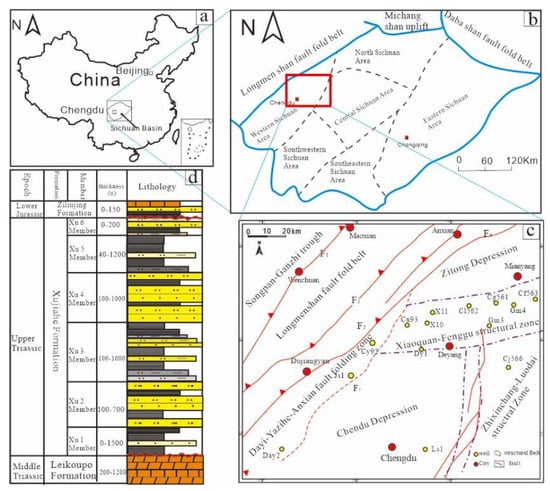
Figure 1.
(a) The location of the Sichuan Basin; (b) Geological setting of the Sichuan Basin; (c) The tectonic divisions of the western Sichuan Basin; (d) Generalized stratigraphy and lithological types of the western Sichuan Basin.
The study area mainly experienced the following two tectonic evolution stages: the Sinian–Middle Triassic tectonic evolution of a passive continental margin and the Late Triassic–Eocene evolution of a foreland basin [,]. The Indosinian movement at the end of the Late Triassic resulted in the collision of the Yangtze plate with the North China plate. The Longmenshan island chain along the western edge of the Sichuan Basin gradually evolved into a strong thrust nappe orogenic belt and entered the stage of foreland basin evolution, and the coal-bearing clastic rocks of the Xujiahe Formation were deposited [,,,,].
The Xujiahe Formation in the Sichuan Basin unconformably overlies the Middle Triassic Leikoupo Formation, which consists of dolomite, dolomitic limestone, and limestone and is also conformably overlain by the Lower Jurassic Ziliujing Formation. From bottom to top, the Xujiahe Formation in the western Sichuan Basin can be divided into five members, namely, Xu1–Xu5 (Figure 1d). The Xu1, Xu3 and Xu5 members mainly consist of black shale, mudstone, and coal seams and are regional petroleum source rocks for the Xujiahe Formation, whereas the Xu2 and Xu4 members are predominantly sandstones, which are an important sandstone reservoir and production layer, respectively, in the western Sichuan Basin [,]. The burial depth of the Xu2 member is more than 4600 m, and the sedimentary thickness is between 560 and 660 m. The Xu2 member was largely deposited in a marine delta front belonging to a marine-to-continental transitional environment, mainly consisting of distributary channel and mouth bar sandstones [,,].
3. Materials and Methods
A total of 102 samples were collected from 8 wells in the Xu2 member in the western Sichuan Basin, at burial depths ranging from 4800–5200 m. Eighty-six samples were selected for thin section observation, and thin sections were prepared for multiple purposes via blue-dyed epoxy impregnation and double-sided polishing. The mineral composition was identified using polarized light microscopy, and X-ray diffraction (XRD) analysis was performed on 22 bulk samples and <2 μm size fractions using a Neo-Confucianism DMAX-3C diffractometer. The geochemical and information of the diagenetic minerals was evaluated via cathodoluminescence (CL) analysis. The instrument model is CL8200MK5, and the analysis was performed at an accelerating voltage of 30 kV, with a 2Na beam current and a 5-millimeter working distance.
Fifteen double-sided polished thin sections were selected for microthermometric measurements. The homogenization temperatures were measured using a Linkam THMS-600 heating/cooling stage. Only primary fluid inclusions containing both aqueous and hydrocarbon phases were selected from the authigenic minerals to determine their minimum precipitation temperatures.
The chemical composition of the quartz cements was quantitatively determined using electron microprobe analysis (EMPA) with an EPMA-1720JXA-8100 electron microprobe (operating conditions: 15-kV accelerating voltage, 10-nA current, and 1-micrometer beam diameter) at the State Key Laboratory of Oil and Gas Reservoir Geology and Exploitation in Chengdu. The accuracy of experimental analysis is −3–+3%. Four thin sections and 24 sample points were analyzed.
Ion microprobe spots were identified using CL and reflected microscopy, and any areas with well-developed quartz cements (>25 μm wide) were cored from the double-thickness polished thin sections and then packed into one block alongside international NBS-28 standard quartz grains. In situ SIMS oxygen isotopic composition analysis of the detrital quartz and quartz overgrowths was conducted using a CAMECA IMS-1280 ion microprobe with an approximately 15-micrometer diameter beam at the Institute of Geology and Geophysics, Chinese Academy of Sciences (IGGCAS) in Beijing, and the internal precision of δ18O was ca. 0.2‰ (2 standard deviations, 2SDs) based on 20 measurement cycles [,].
4. Results
4.1. Petrographic Description
The sandstone of the Xu2 member is mainly composed of fine- to medium-grained litharenites, sublitharenites, and feldspathic litharenites (Figure 2). The detrital composition is primarily quartz, and the sandstone is relatively poor in feldspar and rich in rock fragments. The rock fragments are predominantly metamorphic and igneous rock fragments, while the feldspars are largely potassic feldspars (orthoclase and microcline) with small quantities of plagioclase. The main components of the interstitial materials are clay matrix and cements such as quartz, chlorite, illite, and carbonates.
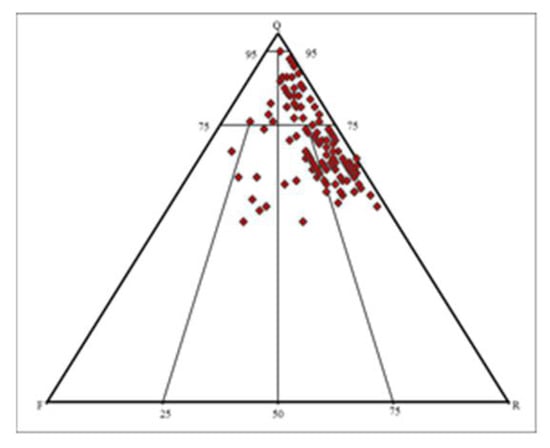
Figure 2.
Ternary diagram based on Folk (1968) illustrating the composition of the Xu2 sandstones. Q-detrital quartz grains, F-detrital feldspar grains, R-rock fragments.
4.2. Diagenesis Types and Characteristics
The compaction and pressure dissolution degrees of the deep-buried sandstone in the Xu2 member are high. According to the thin section analysis, line, concave convex, and stylolite contacts occur between the detrital grains, while mica or plastic rock fragment were deformed by compaction (Figure 3a).
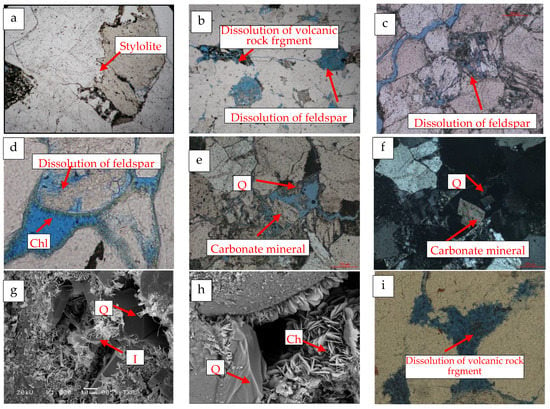
Figure 3.
Photomicrographs showing the diagenesis characteristics of the Xu2 sandstones. (a) Stylolite contact of the quartz detrital grains, CG561 well, 4926.65 m, plane-polarized light (PPL) analysis; (b) Dissolution of feldspar and volcanic rock fragments associated with fractures, intragranular dissolution pores, CX565 well, 4898.31 m, PPL; (c) Dissolution of feldspar associated with fractures, intragranular dissolution pores, ZT1 well, 3667.6 m, PPL; (d) Dissolution of feldspar and chlorite layer, CG561 well, 4992.9 m, PPL; (e) Dissolution of feldspar, carbonate mineral recrystallization, ZT1 well, 3673.05 m, PPL; (f) Dissolution of feldspar, carbonate mineral recrystallization, ZT1 well, 3673.05 m, XPL; (g) Illite and authigenic quartz cements, X10 well, 4880.24 m, SEM; (h) Chlorite-coated and authigenic quartz cements, JH2 well, 3440.42 m, SEM; (i) Dissolution of volcanic rock, CG561 well, 4993.54 m.
K-feldspar dissolution commonly produced secondary pores, which highly improves the reservoir quality of tight sandstones, dissolution was enhanced by fractured grains (Figure 3b,c). Feldspar dissolution mainly occurred along the edges and cleavage surfaces of detrital grains. Some feldspar was largely dissolved to form a honeycomb or hole structure, while the chlorite layer previously covering the detrital grains remains (Figure 3d). It can be seen that carbonate minerals are recrystallized with euhedral outlines and filled in feldspar dissolution pores (Figure 3e,f).
According to the XRD analysis and scanning electron microscopy (SEM) observation, the authigenic clay minerals are primarily chlorite and illite, with no kaolinite. Illite is the most common clay mineral, and it generally occurs as fibrous or hairlike crystals in primary pores as well as within the secondary pores in feldspar grains (Figure 3g). Chlorite is also an important clay mineral in tight sandstone reservoirs, and it usually occurs as rosette-shaped and needle crystals on grain surfaces or in primary pores (Figure 3h).
Quartz cements are volumetrically significant in more mature sandstones and commonly increase with the burial depth. Quartz cements occupy notable amounts of the pore space (7% on average) in the Xu2 sandstones. Three quartz cement formation phases can be distinguished based on the thin section and CL analyses, which are referred to as Q1, Q2, and Q3 (Figure 4). The Q1 quartz cement, which is in direct contact with the quartz grains, is characterized by thin overgrowths surrounding detrital quartz grains and exhibits a slightly gray-black luminescence. It was likely formed earlier than the chlorite- coating (Figure 4a). The subsequently formed Q2 quartz cement is characterized by overgrowths, commonly overlying the Q1 overgrowths, and exhibits a slightly gray-black luminescence, The Q2 quartz cement is volumetrically than Q1 quartz cement (Figure 4b–d). The Q3 quartz cement usually fills intergranular pores and intragranular dissolution pores with euhedral crystals and it exhibits a homogeneous, dark brown luminescence (Figure 4b–d).
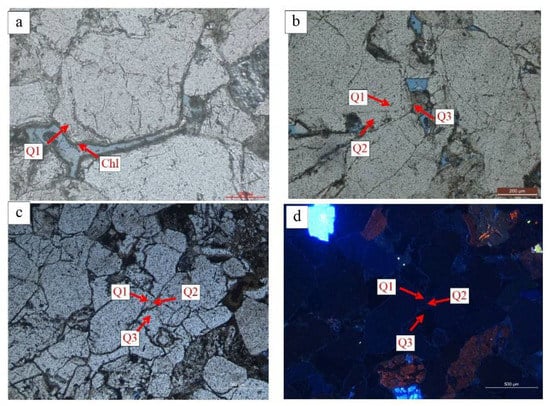
Figure 4.
Photomicrographs showing the characteristics of the quartz cements. (a) Q1 quartz cement, which precipitated earlier than the chlorite-coated did, JH2 well, 3419 m, PPL; (b) Three phases of the quartz cements referred to as Q1, Q2, and Q3, X10 well, 4880.54 m, PPL; (c) Three phases of the quartz cements referred to as Q1, Q2, and Q3, JH2 well, 3440.42 m, PPL; (d) Three phases of the quartz cements referred to as Q1, Q2, and Q3, JH2 well, 3440.42 m, CL.
4.3. Fluid Inclusion Analysis of the Quartz Cements
Fluid inclusion microthermometric data of the quartz cements were acquired for 39 data points. Primary aqueous fluid inclusions commonly occur along the surface (dust rim) separating the detrital grains from the authigenic overgrowths. The data, however, suggest a trimodal distribution, with three distinct temperature intervals of 64–85, 95–125, and 130–170 °C (Figure 5), corresponding to the Q1, Q2, and Q3 quartz cements, respectively.
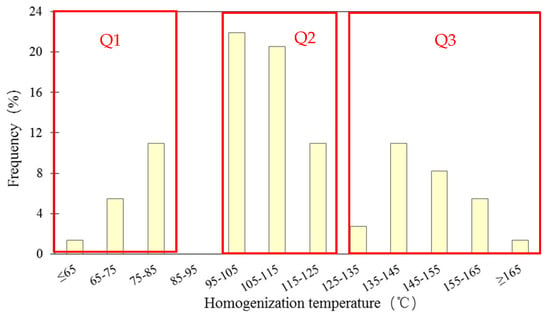
Figure 5.
Histograms of the homogenization temperature (Th) in the different phases of the quartz cements in the Xu2 sandstones.
Hydrocarbon fluid inclusions were mainly found in the Q2 and Q3 quartz cements, which emit blue fluorescence under fluorescence microscopy. Similarly, through analysis of the burial history and temperature, source rock maturation and hydrocarbon migration occurred simultaneously with the growth of the Q2 and Q3 quartz cements [].
4.4. The δ18O Data of the Quartz Cements and Quartz Grains
The δ18O(Vienna Standard Mean Ocean Water (VSMOW)) values of the quartz cements in the Xu2 sandstones range from 6.56 to 18.91‰ (n = 23) (average 14.33‰) and are higher than those of the detrital quartz grains, which range from 6.56 to 8.21‰ (n = 7). The δ18O(VSMOW) value of the Q1 quartz cement ranges from 18.3 to 19.05‰ (n = 6), with an average of 18.61‰, and that of the Q2 quartz cement ranges from 15 to 17.99‰ (n = 7), with an average of 16.76‰, while that of the Q3 quartz cement ranges from 12.79 to 15.47‰ (n = 10), with an average of 14.22‰. These data reveal that the δ18O(VSMOW) value gradually decreases with the distance from the quartz cement to the boundary of the detrital quartz grain (Figure 6, Table 1).
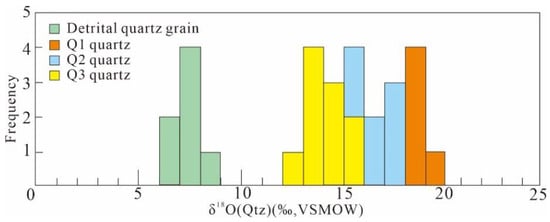
Figure 6.
Histograms of the oxygen isotope ratios of the quartz in the Xu2 sandstones measured in situ, including the cements and detrital quartz grains.

Table 1.
Oxygen isotope ratios of the quartz in the Xu2 sandstones measured in situ, including the cements and detrital quartz grains.
4.5. Electron Probe Analysis of the Quartz Cements
The trace elements in each quartz cement phase were analyzed with the electron microprobe. A summary of the trace element analysis results is shown in Figure 7, and all the data represent the mass fraction percentage. Notably, aluminum exhibits the largest variation across the quartz cement phases. The Q1 quartz cement contains the lowest Al2O3 content with an average of 0.014%. The most volumetrically important Q2 quartz cement exhibits the highest Al2O3 content with a mean value of 0.148%. The Q3 quartz is Al-depleted, with a mean value of 0.075%. Moreover, some Q2 and Q3 quartz cements attains a relatively high K2O content.

Figure 7.
Relationship between Al2O3 and K2O in the different quartz cement phases.
5. Discussion
5.1. Nature and Origin of the Fluid
The δ18O(VSMOW) values of the quartz cements can be employed to analyze the properties of the diagenetic fluids [,,,]. The quartz-water fractionation equation of Clayton et al. (1972) [] is as follows:
1000 lnα (quartz-water) = 3.38 (106 × T−2) − 3.40
The Q1 quartz cement precipitated earlier than the chlorite-coated (Figure 4a), with fluid inclusions exhibiting a homogenization temperature ranging from 64 to 85 °C and a calculated paleofluid δ18O(water) value ranging from −8.16 to −4.05‰ VSMOW, close to the value of meteoric water (−7‰) (Figure 8). The paleofluid may have been influenced by meteoric water. The Q2 quartz cement was mainly formed from 95 to 125 °C, and the calculated paleofluid δ18O(water) value ranges from −6.63 to −0.09‰ VSMOW (Figure 8). Since the oxygen isotope composition of the formation waters generally evolves to more positive values with increasing burial as a result of water-rock reactions, the recrystallization reactions of the clay minerals and hydrocarbon emplacement tend to result in δ18O(water) enhancement [,,,], and it is inferred that the pore fluid maybe the complex high-temperature mixed fluid remaining after hydrocarbon emplacement and water–rock reactions. The Q3 quartz cement primarily formed from 130 to 170 °C, and the calculated paleofluid δ18O(water) value ranges from −4.68to 1.54‰ VSMOW (Figure 8). According to the thermal and burial histories (Figure 9), the burial depth of this stage reached 3500 m, and the pore water δ18O(water) value continuously increased in the middle and late diagenetic stages due to the release of SiO2 by pressure solution and carbonate mineral recrystallization [,,,]. It is inferred that the pore fluid in this stage is mainly the mixed fluid remaining after pressure dissolution and water–rock reaction interactions.
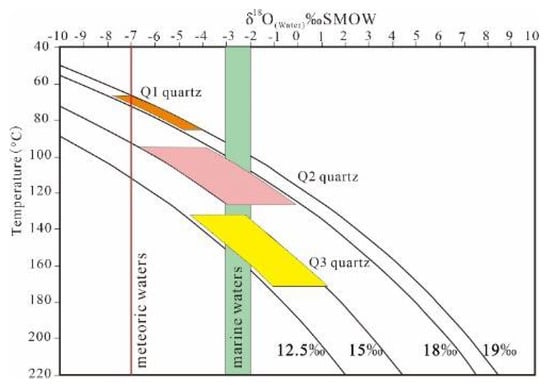
Figure 8.
Plot of δ18O(water) in equilibrium with δ18O(cement) = 12.5, 15, 18, and 19‰ as a function of the temperature [], Late Triassic marine waters, δ18O(water) = approximately −3 to −2‰ [,], and meteoric waters, δ18O(water) = −7‰ [,].
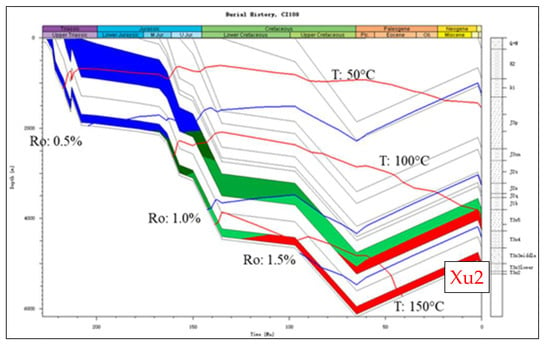
Figure 9.
Burial history of the Xu2 member in Western Sichuan Basin.
5.2. Silica Sources
The potential sources of silica for quartz cementation in the sandstones can be summarized as biogenic silica, feldspar dissolution, clay mineral transformation, and pressure dissolution of detrital quartz grains []. The Q1 quartz cement was mainly formed at a temperature range of 64 to 85 °C, and the isotopic analysis of the Q1 quartz cement reveals a meteoric water influence. Sandstones containing biogenic silica are generally deposited in marine environments, and they could be potential silica sources in the early diagenetic stage, whereas the Xujiahe Formation is a nonmarine deposit. Therefore, biogenic silica is excluded. At low temperatures, meteoric water dissolves volcanic rock fragments and feldspar, thereby releasing silica [,,,,] (Figure 3b,i). The fraction of silica released from the dissolution of feldspar minerals can reach as high as 0.43 cm3 per cm3 of the dissolved feldspar depending on the original composition and type of the feldspar minerals [,]. Therefore, it appears that the dissolution of feldspar and volcanic rock fragments may be the most important source of silica for the Q1 quartz cement.
The Q2 quartz cement was primarily formed from 95 to 125 °C. According to its burial history, the organic acids released from the mature organic matter likely created an acidic environment, which facilitated the precipitation of authigenic quartz [,]. Moreover, the acidic fluid dissolved feldspar, and the pore water was enriched with Al3+, K+, and Na+; authigenic quartz generally also contains a small amount of trace elements []. EPMA analysis reveals that the Q2 quartz cement exhibits a relatively high K2O content, with the highest Al2O3 content (Figure 7). The SEM indicates that the authigenic quartz fills the dissolution pores of the feldspar detrital grains (Figure 10).
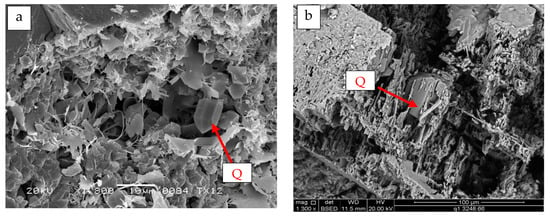
Figure 10.
Scanning electron microscopy images showing the characteristics of the quartz cements. (a) Dissolution pores of rock fragments filled with authigenic quartz and illite, X10 well, 4880.54 m; (b) Dissolution pores of feldspar filled with authigenic quartz, ZT1 well, 3673.05 m.
With an increasing temperature, the smectite in sandstones or adjacent mudstones is gradually transformed into illite or chlorite [,,,]. The original composition of the smectite may determine whether it is transformed into illite or chlorite. Mg Fe-rich smectite tends to be chloritized, whereas K-, Ca-, and Na-rich smectite tend to be illitized [,]. The clay minerals in the Xu2 sandstone are mainly illite and chlorite and are associated with the authigenic quartz (Figure 3g,h). This demonstrates that the transformation of clay minerals could be a potential silica source, but regarding the silica formed in the external shale unit, there must be a suitable transport mechanism for precipitation in the adjacent sandstone reservoir, which is more difficult for the deep-buried thick sandstone of the second member of the Xujiahe Formation. Therefore, the dissolution of feldspar and the transformation of the clay minerals in the Xu2 sandstone appear to have been the most important sources of silica for the Q2 quartz cement.
The Q3 quartz cement formation temperature is generally higher than 130 °C, and the burial depth of the Xu2 sandstone is generally greater than 4500 m. The thin sections reveal that intergranular pressure dissolution and stylolites are common (Figure 3a), indicating that this process could be considered an important source of silica for the Q3 quartz cement. Moreover, mica and illite clay minerals promote quartz grain pressure dissolution to produce free silica [,] (Figure 3a). Therefore, pressure dissolution appears to have been the most important source of silica for the Q3 quartz cement.
6. Conclusions
- Three quartz cement phases are identified based on thin section analysis, CL, and fluid inclusion microthermometry, with three distinct temperature intervals of 56–85, 90–125, and 130–175 °C. Hydrocarbon fluid inclusions are mainly found in the Q2 and Q3 quartz cements, which emit blue fluorescence under fluorescence microscopy.
- The δ18O values of the quartz cements range from 6.56 to 18.91‰ (n = 23) (average: 14.33‰) and are higher than those of the detrital quartz grains. The δ18O(VSMOW) value of the Q1 quartz cement ranges from 18.3 to 19.05‰, that of the Q2 quartz cement ranges from 15 to 17.99‰, while that of the Q3 quartz cement ranges from 12.79 to 15.47‰.
- The Q1 quartz cement has the lowest Al2O3 content with an average of 0.014%. The Q2 quartz cement exhibits the highest Al2O3 content with a mean value of 0.148%. The Q3 quartz cement is Al-depleted, with a mean value of 0.075%. Moreover, some Q2 and Q3 quart cements samples achieve a relatively high K2O content.
- The dissolution of feldspar and unstable volcanic rock fragments appears to have been the most important source of silica for the Q1 quartz cement. The variations in δ18O(water) and trace element composition from the Q2 quartz cement to the Q3 quartz cement suggest that hydrocarbon emplacement and water–rock interactions greatly altered the chemistry of the pore fluid. The dissolution of feldspar, clay mineral transformation, and pressure dissolution appear to have been the most important sources of silica for the Q2 and Q3 quartz cements. The transformation of the clay minerals in the external shale unit was a limited source of silica.
Author Contributions
Conceptualization, Z.L.; formal Analysis, J.W.; data Curation, J.W.; writing—original draft preparation, J.R. and H.W.; writing—review and editing, S.Z. and Z.L. All authors have read and agreed to the published version of the manuscript.
Funding
Our team was supported by the National Science and Technology Major Project [grant number 2016ZX05002-004-010].
Acknowledgments
We thank the anonymous reviewers for their valuable suggestions and kind help in improving the quality of the manuscript, and the Southeast Branch Company of SINOPEC for sample collection and technical support.
Conflicts of Interest
The authors declare no conflict of interest.
References
- Houseknecht, D.W. Influence of Grain Size and Thermal Maturity on Intergranular Pressure Solution and Quartz Cementation in a Quartz-Rich Sandstone. J. Sediment. Petrol. 1984, 54, 348–361. [Google Scholar] [CrossRef]
- Bjorlykke, K.; Egeberg, P. Quartz Cementation in Sedimentary Basins. AAPG Bull. 1993, 77, 1538–1548. [Google Scholar]
- Worden, R.H.; Morad, S. Quartz Cementation in Sandstones; International Association of Sedimentologists, Special Publication, Blackwell Science: Oxford, UK, 2000. [Google Scholar]
- Marchand, A.M.E.; Macaulay, C.I.; Haszeldine, R.S.; Fallick, A.E. Pore water evolution in oilfield sandstones: Constraints from oxygen isotope microanalyses of quartz cement. Chem. Geol. 2002, 191, 285–304. [Google Scholar] [CrossRef] [Green Version]
- Mcbride, E.F. Quartz cement in sandstones: A review. Earth-Sci. Rev. 1989, 26, 69–112. [Google Scholar] [CrossRef]
- Lander, R.H.; Larese, R.E.; Bonnell, L.M. Toward more accurate quartz cement models: The importance of euhedral versus noneuhedral growth rates. Aapg Bull. 2008, 92, 1537–1563. [Google Scholar] [CrossRef]
- Bukar, M. Does Oil Emplacement Stop Diagenesis and Quartz Cementation in Deeply Buried Sandstone Reservoirs; University of Liverpool: Liverpool, UK, 2013. [Google Scholar]
- Van de Kamp, P.C. Smectite-illite-muscovite transformations, quartz dissolution, and Silica release in shales. Clays Clay Miner. 2008, 56, 66–81. [Google Scholar] [CrossRef]
- Harwood, J.; Aplin, A.C.; Fialips, C.; Iliffe, J.E.; Kozdon, R.; Ushikubo, T.; Valley, J.W. Quartz cementation history of sandstones revealed by high-resolution SIMS oxygen isotope analysis. J. Sediment. Res. 2013, 83, 522–530. [Google Scholar] [CrossRef] [Green Version]
- Oye, O.J.; Aplin, A.C.; Jones, S.J.; Gluyasa, J.G.; Bowenb, L.; Orlandc, I.J.; Valley, J.W. Vertical effective stress as a control on quartz cementation in sandstones. Mar. Pet. Geol. 2018, 98, 640–652. [Google Scholar] [CrossRef] [Green Version]
- Walderhaug, O. Kinetic modeling of quartz cementation and porosity loss in deeply buried sandstone reservoirs. AAPG Bull. 1996, 80, 731–745. [Google Scholar]
- Walderhaug, O. Modeling quartz cementation and porosity in Middle Jurassic Brent Group sandstones of the Kvitebjørn field, northern North Sea. AAPG Bull. 2000, 84, 1325–1339. [Google Scholar] [CrossRef]
- Lander, R.H.; Walderhaug, O. Predicting porosity through simulating sandstone compaction and quartz cementation. AAPG Bull. 1999, 83, 433–449. [Google Scholar]
- Hiatt, E.E.; Kurtis, T.K.; Fayek, M.; Polito, P.; Holk, G.J.; Riciputi, L.R. Early quartz cements and evolution of paleohydraulic properties of basal sandstones in three Paleoproterozoic continental basins: Evidence from in situ δ18O analysis of quartz cements. Chem. Geol. 2007, 238, 19–37. [Google Scholar] [CrossRef]
- Hyodo, A.; Kozdon, R.; Pollington, A.D.; Valley, J.W. Evolution of quartz cementation and burial history of the Eau Claire Formation based on in situ oxygen isotope analysis of quartz overgrowths. Chem. Geol. 2014, 384, 168–180. [Google Scholar] [CrossRef]
- Longstaffe, F.J.; Ayalon, A. Oxygen-Isotope Studies of Clastic Diagenesis in the Lower Cretaceous Viking Formation, Alberta: Implications for the Role of Meteoric Water; Geological Society, Special Publications: London, UK, 1987; Volume 36, pp. 277–296. [Google Scholar]
- Guo, Z.W.; Deng, K.L.; Han, Y.H. Formation and Evolution of the Sichuan Basin; Geological Publishing House: Beijing, China, 1996; pp. 1–200, (In Chinese with English Abstract). [Google Scholar]
- Gao, B.; Tian, F.; Pan, R.; Zheng, W.H.; Li, R.; Huang, T.J.; Liu, Y.S. Hydrothermal Dolomite Paleokarst Reservoir Development in Wolonghe Gasfield, Sichuan Basin, Revealed by Seismic Characterization. Water 2020, 12, 579. [Google Scholar] [CrossRef] [Green Version]
- Yue, D.L.; Wu, S.H.; Xu, Z.Y.; Xiong, L.; Chen, D.X.; Ji, Y.L. Reservoir quality, natural fractures, and gas productivity of upper Triassic Xujiahe tight gas sandstones in western Sichuan Basin, China. Mar. Pet. Geol. 2018, 89, 370–386. [Google Scholar] [CrossRef]
- Ni, Y.Y.; Dai, J.X.; Tao, S.Z.; Wu, X.Q.; Liao, F.R.; Wu, W.; Zhang, D.J. Helium signatures of gases from the Sichuan Basin, China. Org. Geochem. 2014, 74, 33–43. [Google Scholar] [CrossRef]
- Lai, J.; Wang, G.W.; Ran, Y.; Zhou, Z.L. Predictive distribution of high-quality reservoirs of tight gas sandstones by linking diagenesis to depositional facies: Evidence from Xu-2 sandstones in the Penglai area of the central Sichuan basin, China. J. Nat. Gas Sci. Eng. 2015, 23, 97–111. [Google Scholar] [CrossRef]
- Tao, S.Z.; Zou, C.N.; Mi, J.K.; Gao, X.H.; Yang, C.; Zhang, X.X.; Fan, J.W. Geochemical comparison between gas in fluid inclusions and gas produced from the Upper Triassic Xujiahe Formation, Sichuan Basin, SW China. Org. Geochem. 2014, 74, 59–65. [Google Scholar] [CrossRef]
- Luo, L.; Meng, W.B.; Gluyas, J.; Tan, X.F.; Gao, X.Z.; Feng, M.S.; Kong, X.Y.; Shao, H.B. Diagenetic characteristics, evolution, controlling factors of diagenetic system and their impacts on reservoir quality in tight deltaic sandstones: Typical example from the Xujiahe Formation in Western Sichuan Foreland Basin, SW China. Mar. Pet. Geol. 2019, 103, 231–254. [Google Scholar] [CrossRef] [Green Version]
- Zhang, S.L.; Lv, Z.X.; Wen, Y.; Liu, S.B. Origins and Geochemistry of Dolomites and Their Dissolution in the Middle Triassic Leikoupo Formation, Western Sichuan Basin, China. Minerals 2018, 8, 289. [Google Scholar] [CrossRef] [Green Version]
- Zhang, L.; Guo, X.S.; Hao, F.; Zou, H.Y.; Li, P. Lithologic characteristics and diagenesis of the upper triassic Xujiahe Formation, yuanba area, northeastern Sichuan Basin. J. Nat. Gas Sci. Eng. 2016, 35, 1320–1335. [Google Scholar] [CrossRef]
- Xu, C.M.; Gehenn, J.M.; Zhao, D.H.; Xie, G.Y.; Teng, M.K. The fluvial and lacustrine sedimentary systems and stratigraphic correlation in the Upper Triassic Xujiahe Formation in Sichuan Basin, China. AAPG Bull. 2015, 99, 2023–2041. [Google Scholar] [CrossRef]
- Yuan, G.H.; Cao, Y.C.; Gluyas, J.; Cao, X.; Zhang, W.B. Petrography, fluid-inclusion, isotope, and trace-element constraints on the origin of quartz cementation and feldspar dissolution and the associated fluid evolution in arkosic sandstones. AAPG Bull. 2018, 102, 761–792. [Google Scholar] [CrossRef]
- Li, X.H.; Li, Z.X.; He, B.; Li, W.X.; Li, Q.L.; Gao, Y.Y.; Wang, X.C. The Early Permian active continental margin and crustal growth of the Cathaysia Block: In situ U-Pb, Lu-Hf and O isotope analyses of detrital zircons. Chem. Geol. 2012, 328, 195–207. [Google Scholar] [CrossRef]
- Clayton, R.N.; O’Neil, J.R.; Mayeda, T.K. Oxygen isotope exchange between quartz and water. J. Geophys. Res. 1972, 77, 3057–3067. [Google Scholar] [CrossRef]
- Aplin, A.C.; Warren, E.A. Oxygen isotopic indications of the mechanisms of silica transport and quartz cementation in deeply buried sandstones. Geology 1994, 22, 847–850. [Google Scholar] [CrossRef]
- Wilkinson, M.; Crowley, S.F.; Marshall, J.D. Model for the evolution of oxygen isotope ratios in the pore fluids of mudrocks during burial. Mar. Pet. Geol. 1992, 9, 98–105. [Google Scholar] [CrossRef]
- Girard, J.P.; Munz, I.A.; Johansen, H.; Hill, S.; Canham, A. Conditions and timing of quartz cementation in Brent reservoirs, Hild Field, North Sea: Constraints from fluid inclusions and SIMS oxygen isotope microanalysis. Chem. Geol. 2001, 176, 73–92. [Google Scholar] [CrossRef]
- Muttoni, G.; Mazza, M.; Mosher, D.; Katz, M.E.; Kent, D.V.; Balini, M. A Middle-Late Triassic (Ladinian-Rhaetian) carbon and oxygen isotope record from the Tethyan Ocean. Palaeogeogr. Palaeoclimatol. Palaeoecol. 2014, 399, 246–259. [Google Scholar] [CrossRef]
- Korte, C.; Kozur, H.W.; Veizer, J. δ13C and δ18O values of Triassic brachiopods and carbonate rocks as proxies for coeval seawater and palaeotemperature. Palaeogeogr. Palaeoclimatol. Palaeoecol. 2005, 226, 287–306. [Google Scholar] [CrossRef]
- Liu, S.B.; Huang, S.J.; Shen, Z.M.; Lv, Z.X.; Song, R.C. Diagenetic fluid evolution and water-rock interaction model of carbonate cements in sandstone: An example from the reservoir sandstone of the Fourth Member of the Xujiahe Formation of the Xiaoquan-Fenggu area, Sichuan Province, China. Sci. China Earth Sci. 2014, 57, 1077–1092, (In Chinese with English Abstract). [Google Scholar] [CrossRef]
- Hurst, A.; Irwin, H. Geological modelling of clay diagenesis in sandstones. Clay Miner. 1982, 17, 5–22. [Google Scholar] [CrossRef]
- Franca, A.B.; Aranujo, L.M.; Maynard, J.B.; Potter, P.E. Secondary porosity formed by deep meteoric leaching: Botucatu eolianite, southern South America. AAPG Bull. 2003, 87, 1073–1082. [Google Scholar] [CrossRef]
- Liu, Y.F.; Hu, W.X.; Cao, J.; Wang, X.L.; Tang, Q.S.; Wu, H.G.; Kang, X. Diagenetic constraints on the heterogeneity of tight sandstone reservoirs: A case study on the Upper Triassic Xujiahe Formation in the Sichuan Basin, southwest China. Mar. Pet. Geol. 2018, 92, 650–669. [Google Scholar] [CrossRef]
- Sun, H.T.; Zhong, D.K.; Zhan, W.J. Reservoir characteristics in the Cretaceous volcanic rocks of Songliao Basin, China: A case of dynamics and evolution of the volcano-porosity and diagenesis. Energy Explor. Exploit. 2019, 37, 607–625. [Google Scholar] [CrossRef] [Green Version]
- Leder, F.; Park, W. Porosity reduction in sandstone by quartz overgrowth. Aapg Bull. 1986, 70, 1713–1728. [Google Scholar]
- Morad, S.; AlDahan, A.A. A SEM study of diagenetic kaolinitization and illitization of detrital feldspar in sandstones. Clay Miner. 1987, 22, 237–243. [Google Scholar] [CrossRef]
- Zaid, S.M. Provenance, diagenesis, tectonic setting and geochemistry of Rudies sandstone (Lower Miocene), Warda Field, Gulf of Suez, Egypt. J. Afr. Earth Sci. 2012, 66–67, 56–71. [Google Scholar] [CrossRef]
- Perry, E.A.; Hower, J. Burial diagenesis in Gulf Coast pelitic sediments. Clay Clay Miner. 1970, 18, 167–177. [Google Scholar] [CrossRef]
- Lynch, F.L.; Mack, L.E.; Land, L.S. Burial diagenesis of illite/smectite in shales and the origins of authigenic quartz and secondary porosity in sandstones. Geochim. Cosmochim. Acta 1997, 61, 1995–2006. [Google Scholar] [CrossRef]
- Chang, H.K.; Mackenzie, F.T.; Schoonmaker, J. Comparisons between the diagenesis of dioctahedral and trioctahedral smectite, Brazilian offshore basins. Clays Clay Miner. 1986, 34, 407–423. [Google Scholar] [CrossRef]
- Oelkers, E.H.; Bjorkum, P.A.; Murphy, W.M. A petrographic and computational investigation of quartz cementation and porosity reduction in North Sea sandstones. Am. J. Sci. 1996, 296, 420–452. [Google Scholar] [CrossRef]
- Walderhaug, O. Kaolin-Coating of Stylolites, Effect on Quartz Cementation and General Implications for Dissolution at Mineral Interfaces. J. Sediment. Res. 2006, 76, 234–243. [Google Scholar] [CrossRef]
Publisher’s Note: MDPI stays neutral with regard to jurisdictional claims in published maps and institutional affiliations. |
© 2021 by the authors. Licensee MDPI, Basel, Switzerland. This article is an open access article distributed under the terms and conditions of the Creative Commons Attribution (CC BY) license (https://creativecommons.org/licenses/by/4.0/).